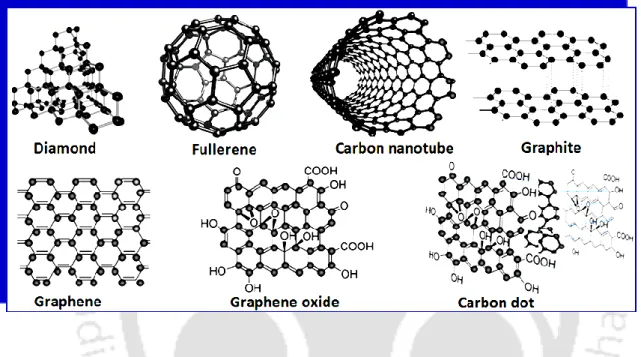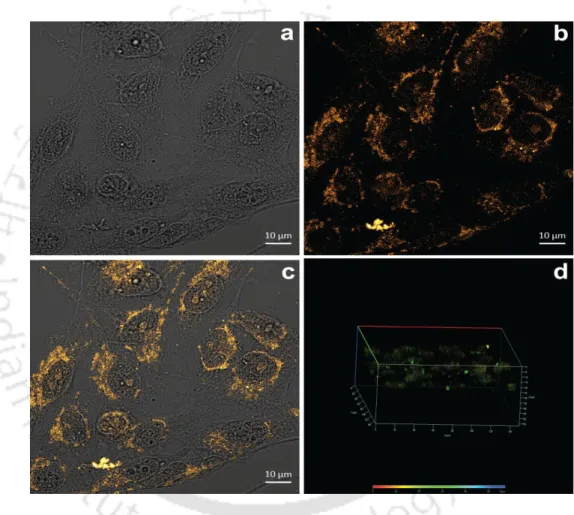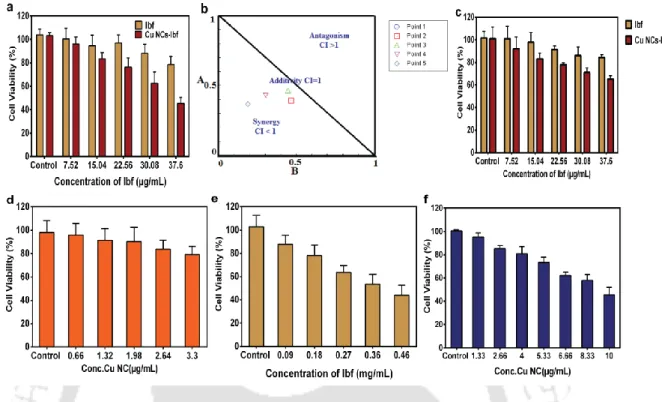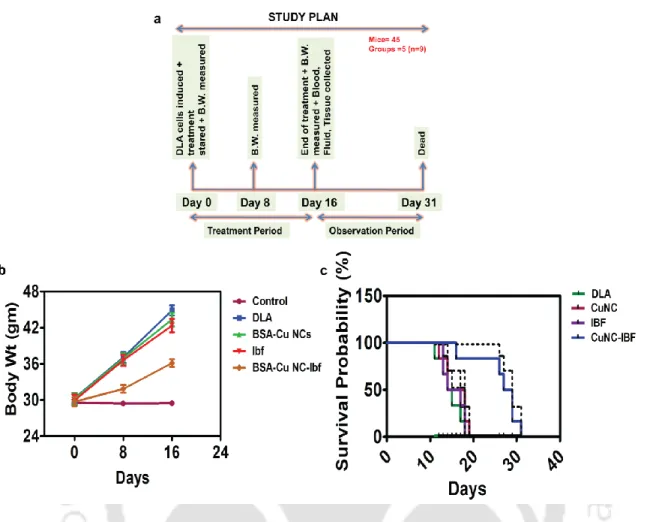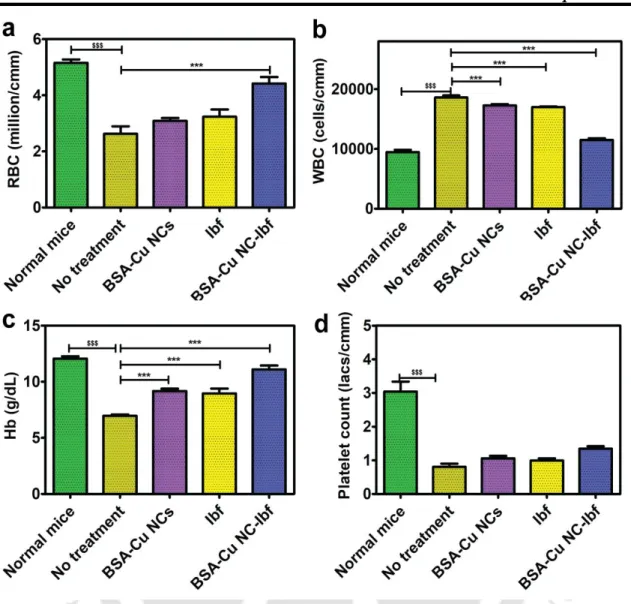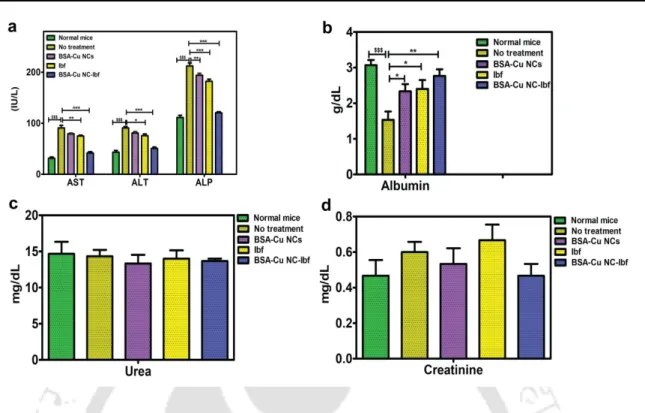Introduction and Literature Review 1
Introduction 3
The term nano (derived from the Greek word nanos, meaning dwarf) refers to a factor of 10−9 (one billionth) a unit prefix1-2 in both the International System of Units (SI) and the non-SI units. Nanoscience is the branch of science that deals with the study of materials on the scale of nanometers (1-100 nm) in at least one dimension.3 Nanotechnology, on the other hand, deals with tools and techniques to manipulate nanoscale objects at the molecular level.4 Nanoscale objects or nanomaterials are gaining immense importance due to their superior chemical, physical, optical, magnetic, thermal, electrical, imaging, and mechanical properties compared to their conventional counterparts.5-7 Due to these unique properties make them highly desirable for applications in various disciplines such as agriculture, catalysis, chemistry, commercial, electronics, environmental sectors, food industry, physics, solar cells and also in biomedical healthcare.6 By acquiring knowledge from nanoscience about material behavior of objects at the nanoscale, nanotechnology focuses on the construction of various nanomaterials for widespread applications1,4 in photonics, electronics and medicine.8 Especially in medicine, several nanoplatforms have been widely explored for biosensing,9 bioimaging9 drug delivery, gene therapy, tissue engineering and nanomedicine.10.
Nanoscale Materials 3
This classification is not limited to the 1–100 nm range of the nanometer scale.6,12 Nanomaterials are extremely important because of their superior chemical, physical, optical, magnetic, thermal, electrical, imaging, and mechanical properties compared to their conventional counterparts.5–7 Because These unique properties make them highly desirable for use in various disciplines such as agriculture, catalysis, chemistry, commercial, electronics, environmental sectors, food industry, physics, solar cells and also in biomedical healthcare.6 Nanomaterials can be of various types, e.g. . , nanoclusters, nanoparticles, nanocomposites, nanocapsules, nanoporous materials, nanofibers, fullerenes, nanowires, single-walled and multi-walled (carbon) nanotubes, etc. 13.
Nanoparticles 4
Inorganic nanoparticles are better candidates for cancer imaging and treatment due to the plasmonic and magnetic properties of some inorganic nanoparticles.6 Inorganic nanoparticles embedded in organic components can be used for the next generation of theranostics, as they reveal the properties of both types of nanoparticles.15 In Figure 1.2. Different carbon-based nanoparticles are carbon nanotubes (CNTs), carbon nanofibers, carbon blacks, fullerenes, graphenes, and nano-sized activated carbons.6,16 Schematic examples of some common types of carbon-based nanoparticles are shown in Figure 1.3.
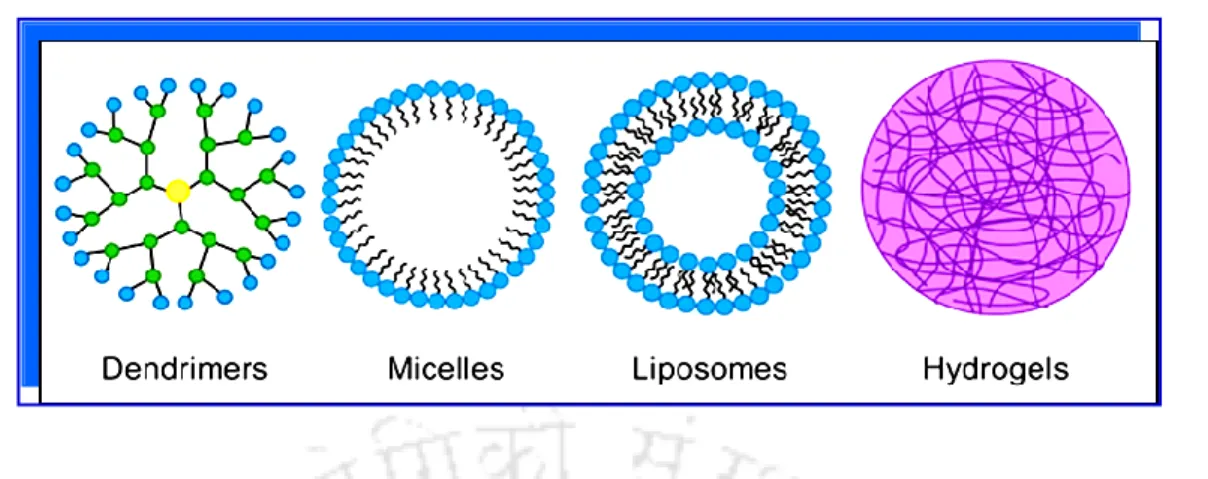
Metallic Nanoparticles 6
It is simple, flexible and most importantly the size and shape of the Cu NPs can be controlled by optimizing the reaction conditions. Due to the inherent tendency to oxidize under atmospheric conditions, the synthesis of copper nanoparticles is much more difficult than the other precious metal nanoparticles.
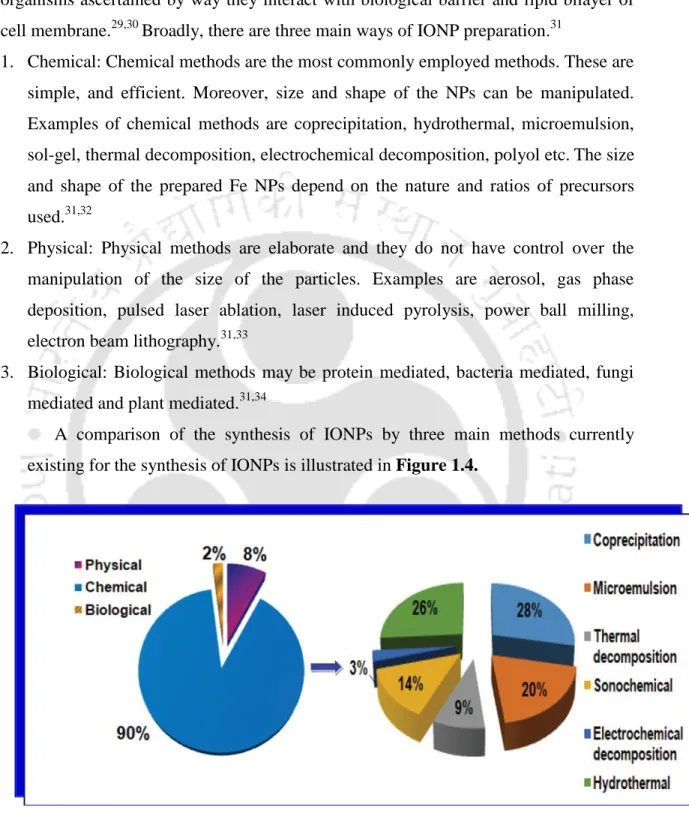
Nanoclusters 12
Highly fluorescent quality of the Cu NCs endows them with photo as well as chemical stability. Recently, highly fluorescent Cu NCs have received much attention for biolabeling and bioimaging applications due to their ultrafine size, excellent biocompatibility, and nontoxicity.
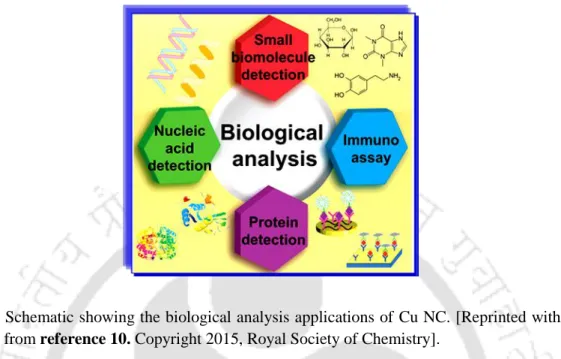
Nanocomposites 20
Key areas and scopes 21
Salient features and significance of the present study 21
The in vitro antimicrobial property of the Sand-Fe-Cu nanocomposites (synthesized after ball milling of sand) was also determined on Gram positive cocci, both methicillin sensitive (MSSA) and methicillin resistant S. Antibacterial activity of the nanocomposite powder on (a ) Gram-positive cocci (methicillin-resistant Staphylococcus aureus) and (b) Gram-negative bacilli (Escherichia coli).
Integration of Nonsteroidal Anti-Inflammatory Drug with Luminescent Copper
Introduction 33
Various anti-inflammatory agents, including nonsteroidal anti-inflammatory drugs (NSAIDs), have been investigated for cancer therapy and prevention. A number of clinical trials suggest that the combined use of anti-inflammatory agents with conventional chemotherapeutic agents can provide satisfactory results.
Outline of the Present Work 35
And in recent times, the repositioning of NSAIDs through nanotechnology has opened up tremendous opportunities in cancer therapy.38.
Experimental Section 36
The method for repositioning ibuprofen and thus formulating the nanomedicine was a modified version of the previously used methods.41.
Characterization 37
The change in dynamic light scattering (DLS) along with the net surface charge (zeta potential) of the BSA-CuNC-Ibf was measured using Malvern Zeta Size Nano ZS-90 instrument. Total WBC count of the peritoneal fluid was estimated using fully automated hematology analyzer (Coulter LH750 Analyzer, Beckman Coulter, USA).
Results and Discussions 44
The histogram plot of the synthesized BSA-Cu NC-Ibf nanodrug was shown in Figure 2.3b. Whereas the percentage of lymphoma cells in the ascites fluid of the mice treated with BSA-CuNC-Ibf was found to be significantly reduced to 89% (Table 2.7 and Figure 2.11d).
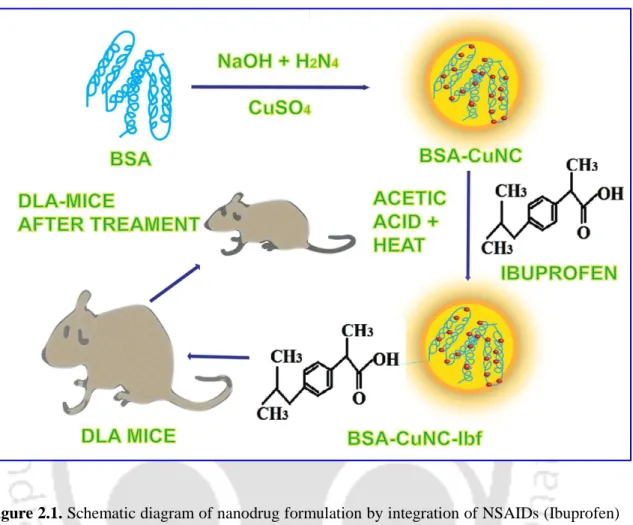
Conclusion 63
Sections of the kidney (Figure 2.14f-j) showed no tumor cell metastasis, except features of acute tubular necrosis in the form of pyknotic nuclei of tubules, intensely eosinophilic cytoplasm and effacement of epithelial cells in some places, which is a frequent phenomenon in postmortem. cases due to acute ischemia of the renal artery before death. Histopathological images of liver (a−e) and kidney (f−j), stained with hematoxylin and eosin where part (a and f) represents negative control (normal mice), (b and g) DLA mice without treatment (c and h ) ) DLA mice treated with BSA-Cu NCs, (d and i) DLA mice treated with Ibf, (e and j) DLA mice treated with BSA-CuNC-Ibf.
Thus, the combination therapy results of the current study bring new hope to cancer therapy. Chapter 3 reported the facile synthesis of iodine-stabilized bimetallic Fe-Cu-nanocomposites on the surface of river bank sand of the Brahmaputra River (in India) under normal atmospheric conditions.
Introduction 69
Since their mechanism of action is absolutely different from that of the conventional antibiotics, they are found to be effective against MDR bacteria.2,3. Herein, synthesis of iodine-stabilized bimetallic Fe-Cunano composites on the surface of the Brahmaputra riverbank sand under normal atmospheric conditions was reported.
Outline of the Present Work 72
So, the present invention is directed towards the preparation of potent, stable, reusable and cost-effective nanocomposites that exhibit strong antimicrobial activity against a wide range of microbes, namely multidrug-resistant bacteria and fungi.
Experimental Section 72
The method used here for making Fe-Cu nanocomposites on sand was a modified version of the methods used previously. Thereafter, the ground sand was used for the synthesis of sand-Fe-Cu nanocomposites following the same procedure as mentioned before.
Characterization 74
The antimicrobial activity of the Sand-Fe-Cu nanocomposites was determined by Lawn culture method. Control experiments for the treatment of nanocomposites were performed with (1) 50 µL of copper solution prepared by dissolving 250 mg of copper sulfate pentahydrate salt in 50 mL of Milli-Q water, (2) Sand-Fe nanocomposites, (3) Sand- Cu nanocomposites and (4) Sand-Fe-Cu nanocomposites both on GPC and GNB.
Results and Discussions 77
For this, the bactericidal activity of the as-synthesized Sand-Fe-Cu nanocomposites on Gram-positive B was determined. Antimicrobial activity of the nanocomposites (synthesized after ball milling of sand) tested on (a-top) Gram-positive cocci-methicillin sensitive S.
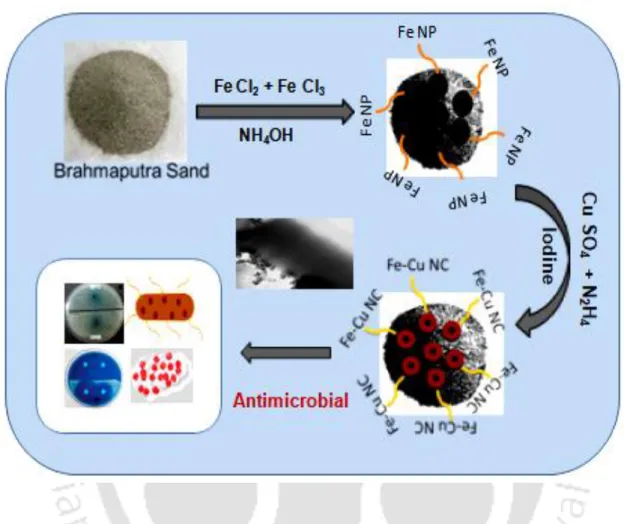
Conclusion 92
Photograph of plates representing the results of control experiments on both GPC (a) and GNB (b) where 1-Copper solution, 2-Sand-Fe nanocomposites, 3-Sand-Cunanocomposites and 4-Sand-Fe-Cu nanocomposites.
The schematic representation of the application of the sand-Fe-Cu nanocomposite for water treatment is shown in figure 4.1. Photographs of (a) the dressing material in powder form (Fe-Cu nanocomposite) and (b) the dressing bed prepared in swab by impregnating bimetallic Fe-Cu nanocomposite.
Fabrication of a Hand Held Water Filter Utilizing Sand-Fe-Cu Nanocomposite
Introduction 99
Although sand has long been the primary source of water purification, it has no antimicrobial properties. Since the removal of pathogenic microorganisms is the most important step of water filtration, the prepared nanocomposites were first tested to filter a wide range of microbes known to cause waterborne diseases.
Outline of the Present Work 99
Experimental Section 101
For this, a portable filter unit was created that held the nanocomposites between two sponge-assisted falcon tubes. For the practical application of the synthesized nanocomposite for water filtration, a portable filtration device was fabricated using two hawk plastic tubes holding the nanocomposites in the middle of one tube and the sand in the other with the help of a sponge.
Characterization 102
The concentrations of the metals in the filtrates were measured by atomic absorption spectroscopy (Varian AA-240, Atomic Absorption Spectrophotometer with GTA 120, The Netherlands). The dried nanocomposites were again placed in the filtration device and filtration was performed.
Results and Discussions 105
Results of re-incubation of the nanocomposites filtrate with bacterial suspensions, where (a) represents plate of A. To show the recyclability properties of the nanocomposites, bacterial suspensions were filtered through raw sand and sand-Fe-Cu nanocomposites after washing them.
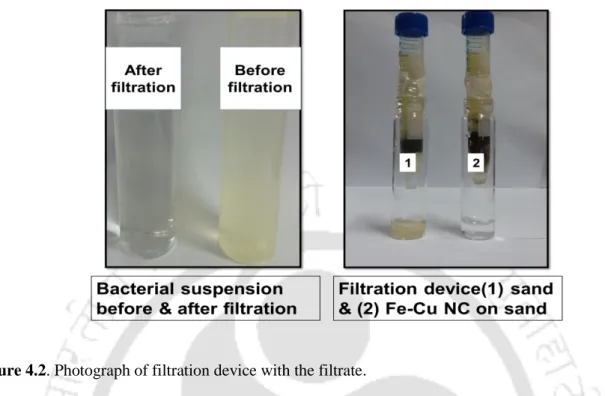
Conclusion 113
To ensure the safe usability of the prepared nanocomposites, the leaching of iron and copper from the nanocomposites was tested using atomic absorption spectroscopy. The results indicated the suitability of using the composite not only for the destruction of bacteria, but also for water purification (especially heavy metal removal).
The stability of both prepared dressing materials was studied by checking the antimicrobial activity of the dressing materials after one month of preparation on methicillin-resistant S. The toxicity level of the prepared dressing materials was assessed by a standard hemolysis assay as follows.
Iron-Copper Bimetallic Nanocomposite Reinforced Dressing Materials for
Introduction 119
The dressing helps prevent infection, relieve pain, facilitate gas exchange, prevent scarring, and aid in skin regeneration and healing.1,2 The course of wound healing is a complex and well-organized process. To date, a variety of natural polymers, such as polysaccharides, proteoglycans and proteins, as well as synthetic polymers have been tried for rapid healing of wounds in addition to controlling infections.3,9-11 However, most of these polymers lack biological activity and the ability to accelerate the wound healing process.
Outline of the Present Work 121
Herein, synthesis of bimetallic wound healing materials in both powder and thin film forms was reported that showed antimicrobial activity against methicillin-resistant Staphylococcus aureus (MRSA) and also exhibited in vivo wound healing properties. Bimetallic nanoparticles in the presence of stabilizers showed enhanced bactericidal activity as their constituents.30 Also, compared to single metal nanoparticles, low concentration bimetallic nanoparticles showed higher antimicrobial and antimycotic activities against a wide range of multidrug-resistant bacteria and fungi.31 Therefore, emphasis was given on the preparation of a biodegradable and durable bimetallic dressing bed with broad-spectrum antibacterial and antifungal properties against multidrug-resistant microbes.
Experimental Section 122
Then the soaked cotton swabs were placed in a separate beaker to which 3-4 ml of NH4OH solution was added. When the swabs turned dark brown, indicating the formation of iron oxide nanoparticles, the extra NH4OH solution was discarded.
Characterization 123
To check the efficacy of the synthesized wound healing materials (powder and swab), in vitro antimicrobial properties of both dressing materials were first tested on pathogenic S strains. To this end, the toxicity level of the prepared dressing materials was assessed by standard hemolysis test.
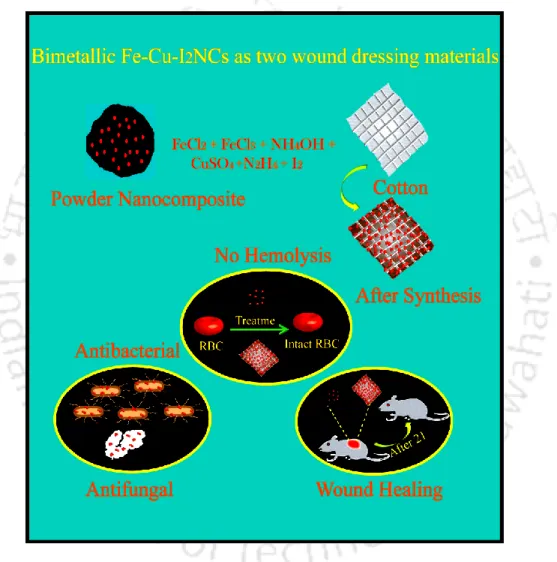
Results and Discussion 130
Conclusion 150
Several binding materials are commercially available, while research is ongoing to design new materials for better and faster wound healing. Prepared biocompatible dressings can be useful for the treatment of acute and chronic infected wounds.
A wide range of microbes, responsible for water-borne diseases, were effectively tested through this filtration device, along with some hazardous metals, confirming the successful potential of the nanocomposite in water filtration. Researchers can be persuaded to develop wound-healing dressing materials on cotton or adhesive strips.
Conclusions and Future Prospects 155
Summary of the thesis 157
In light of the antimicrobial properties of copper nanoparticles, a bimetallic nanocomposite was subsequently formulated to eradicate multidrug-resistant organisms. The emergence of multidrug-resistant bacterial strains, associated with the unavailability of newer antimicrobial agents, projects an alarming panorama in the field of infection management.
Future Prospects 158
For this, a portable hand filtration device was produced using some materials commonly used for on-the-spot water filtration at an affordable cost. Bimetallic Fe-Cu nanocomposites on sand particles for the inactivation of clinical isolates and water filtration at the point of use.
